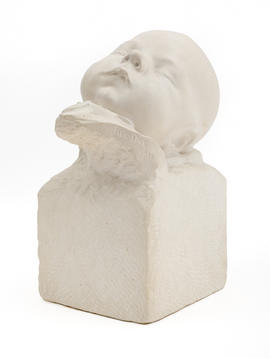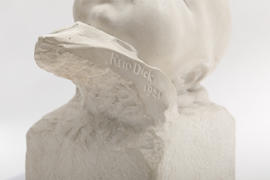Key Information
Reference code
Title
Date(s)
- 1921 (Creation)
Level of description
Item
Extent
1 item
Content and Structure
Scope and content
Plaster cast sculpture of artist's son as a baby, inscribed with creator's name and date. The sculpture of the baby's head is mounted on a plinth. The baby is sleeping.
Appraisal, destruction and scheduling
Accruals
System of arrangement
General Information
Name of creator
Biographical history
Dick, Sir William Reid (1879–1961), sculptor, was born on 13 January 1879 in Glasgow, the son of Francis Dick, a journeyman engine fitter, and his wife, Elizabeth Reid (died c1940). Little is known about the family, but there were 6 known children, two of whom were named Annie and Cathie. Reid Dick was ambitious to sculpt, and at the age of twelve was apprenticed to Scott and Rae, stonemasons, in Glasgow. For five years he learned to carve stone, including granite, and attended drawing and modelling classes at night school. In 1899, as a carver with a firm of stone decorators, he registered at the Glasgow School of Art, studying at night until he received his diploma in 1907. He accepted a post as art master at Bellshill Academy in Glasgow (1907–8), but, when first exhibiting at the Royal Academy in 1908 his address was 6 Clifton Hill Studios, St John's Wood, London.
When new to the city, Reid Dick worked as studio assistant to E. Whitney Smith and attended evening classes at the Kennington School of Art. His first noted commission was a portrait of Harry Lauder (marble, exh. RA, 1911). His reputation grew rapidly, and in 1914 he married Catherine Emma, daughter of William John Treadwell of Northampton. They moved to 1 St John's Wood Studios, Queen's Terrace, where they lived until 1924. They had three children, John, Ann, and Mary, at least one of whom was born at their next home, 31 Grove End Road, St John's Wood. In 1938 Reid Dick bought the house and vast studio at 16 Maida Vale (once occupied by the sculptor Alfred Gilbert), where he and his wife lived until his death in 1961.
In September 1914 Reid Dick joined the ranks of the Territorial Army, going on to serve with the Royal Engineers in France and Palestine from 1915 to 1919. While abroad he amused himself carving small figures in trench chalk, some of which were shown and sold at ‘several London Galleries’ (Reid Dick Archive). He received early recognition for his work, becoming an associate of the Royal Society of British Sculptors in April 1915; he was elected a fellow in August 1923, won the society's silver medal in 1928, and was its president from 1933 to 1938. Following the armistice in 1918, his bronze mask Androdus was bought for the Chantrey collection (exh. RA, 1919; Tate collection). In 1921 he was elected an associate of the Royal Academy, and a member in 1928.
Reid Dick's reputation for monumental sculpture was established after the First World War. Memorials at Bushey and Rickmansworth, Hertfordshire (1921), were followed by a major commission, the Kitchener memorial chapel (1922–5) in St Paul's Cathedral, London, the formal clarity of which became his hallmark. The Pietà in the chapel is one of his finest achievements (sketch model exh. RA, 1922, model 1923, unfinished 1924, marble 1925, original sketch model 1942, study 1953, study 1962). For the architect Sir Reginald Blomfield he made an eagle for the Royal Air Force memorial, Westminster, and the lion for the Menin Gate at Ypres, Belgium (1927). Among his individual memorials are those to David Livingstone at Victoria Falls, Zimbabwe (model exh. RA, 1934), George V in Westminster Abbey (models exh. RA, 1939 and 1941), President Franklin Delano Roosevelt in Grosvenor Square, London (1948; study exh. RA, 1949), and Lady Godiva in Coventry (model exh. RA, 1950).
Reid Dick's architectural works include bas-reliefs for Selfridges, Oxford Street, London (1928), where he later supervised elaborate temporary decorations celebrating the coronation of George VI in 1937; Controlled Energy, two colossal stone groups for Unilever House, Blackfriars, London (1932); figures for St Andrew's House, Edinburgh (1939); and the bronze Herald for the Reuters Building, Fleet Street, London (model exh. RA, 1939). As a portraitist his reputation blossomed after his marble mask of Lady Diana Duff Cooper was shown at the Royal Academy in 1922. A bust of George V (1933) was the first of fourteen royal portraits exhibited at the academy. Other notable sitters included Winston Churchill (bronze, exh. RA, 1943).
Reid Dick was created KCVO in 1935 and subsequently attended many private and public royal gatherings. In 1938 George VI appointed him sculptor-in-ordinary for Scotland (appointment continued 1952–61). He became an honorary Royal Scottish Academician in 1939. He made numerous memorials to George V, Queen Mary, and George VI at the royal residences at Windsor, Balmoral, and Sandringham.
According to The Times obituary, Reid Dick was stocky and robust in appearance, with quiet manners and a very soft voice. Alfred Munnings recalled him as ‘a simple-minded, short, thick-set raw young Scot’ (Munnings, 200). A witty conversationalist at ease in any company, he was liked and admired by his colleagues, and his wide circle of friends included many architects and artists. Straightforward, dynamic, and convivial, he combined a punishing workload with a social life which ranged from grand dinners and parties to the relaxed surroundings of the Chelsea Arts Club. During a bombing raid in 1944 the confident and unflappable Reid Dick, ‘a strong tumbler of whisky in his hand, and several inside his body, defied the enemy, scorning to take cover as he leaned against the fireplace in the hall’ (ibid., 188).
Reid Dick served on many committees, including the Royal Mint advisory committee (1934–5), the council of the British School at Rome (1930s), and the council of the Royal Academy (1930s). He was also a trustee of the Tate Gallery (1934–41), a royal fine arts commissioner (appointed 1938), and a chairman of the sculpture committee for the London Olympic games in 1948. In 1933 he was made an honorary fellow of the Royal Society of Arts, receiving the society's Albert medal in 1948 for ‘National Memorials in Living Stone’.
Reid Dick was a major figure in academic sculpture, a consummate craftsman who combined respect for the past with a passionate search for new conventions. His firm belief that sculpture was at its best when related to architecture informed his entire career. Long dismissed as merely a reactionary monument maker devoid of creativity, critical reassessment by Benedict Read in 1986 revealed his true artistic importance. It lay, ironically, in the innovative stylization of form and material simplicity of his smaller pieces such as Madonna (marble, exh. RA, 1922). This vital dash of modernity injected into the traditions of the academy was followed by further figurative experiment by artists such as Charles Sargeant Jagger, Charles Wheeler, and William Macmillan.
William Reid Dick died at his home, 16 Maida Vale, London, on 1 October 1961 and was cremated on 4 October after a memorial service at Golders Green crematorium; his wife survived him. On 17 October 1963 a memorial tablet was unveiled in the crypt of St Paul's Cathedral during a service attended by many artists and architects. The president of the Royal Academy, Sir Charles Wheeler, gave the oration.
Archival history
Custodial history
Donated by Caroline Eadie, Jul 2022.
Physical Description and Conditions of Use
Conditions governing access
Conditions governing reproduction
Language of material
Script of material
Language and script notes
Physical Description
Plaster.
Dimensions: 260 x 140 x 140 mm
Finding aids
Related Material
Existence and location of originals
Existence and location of copies
Related materials
Notes area
Alternative identifier(s)
Keywords/Tags
Subjects
Place access points
People and Organisations
Genre access points
Status
Level of detail
Processing information
Catalogued by Meredith Pinch, work placement student, Jun 2024.
Language(s)
- English







